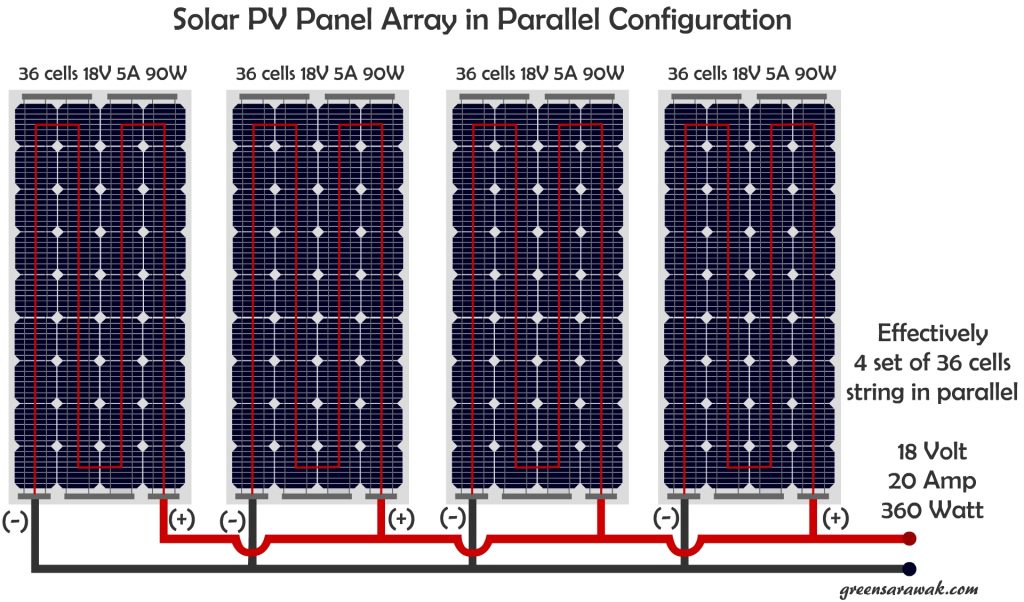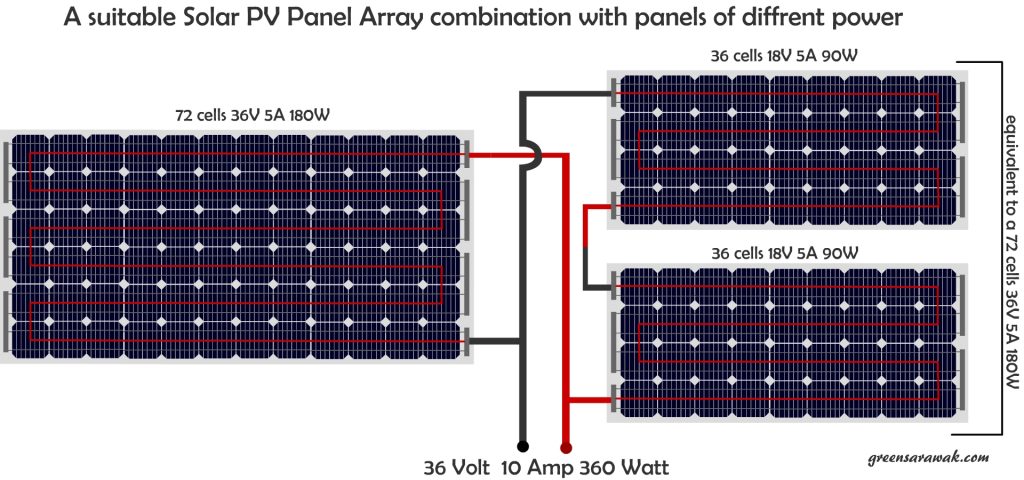There is two ways of wiring your solar PV panels – Series or Parallel or mixture of both. How to wire your panels will depends on whats your aim and what the subsequent devices can support.
Series or String Configuration
Similar to putting batteries in series, it will have the compounding voltage after each connection. Two 1.5 volt battery will generate total 3 (1.5 + 1.5) Volt if placed one after the other with positive on one battery connected to a negative of another battery. The more in series will have move voltage delivered after the chain. However the Amperage will be the same and limited to the battery with the highest resistance in the chain.

In a solar PV panel, all the solar PV cells is connected in series to produce enough voltage to be used in charging a battery system. Remember each solar cell will typically generate ~ 0.5 Volt under standard test condition.
In a solar PV array, many people would like to series their panels to generate the highest voltage acceptable by the solar charge controller or inverters. It will be as high as 150 Volts DC in a MPPT controller. In solar PV setting , it is called a “string”, like a string of Christmas lights which one is link after the other.
The pros in having panel in series:
- Allows of using smaller wires: It is important to know that the wire will carry more power on a smaller wires if you increase the voltage. Ever wondering how few apparently small wire hanging on the power utility grid (national grid) can carry enough power to power up a city ? The tricks is using very high voltage, commonly 33 Kilo Volts (33000 Volts) and can be up to 765 Kilo Volts (in a transmission line from a power station. Since the voltage is high, the amperage carried across the wire will be small as Power (Wattage) is equals to Potential Difference (Volts) times Current (Amperage). Smaller sized wires is usually cheaper than having huge wires.
- Reduce loss during transmission : With high voltage lower Amperage, the loss via heat loss during transmission in a wire will be smaller. It will have a higher working efficiency solar PV system.
- Allow longer wiring from solar PV Panel to other devices : With higher voltage lower amperage, and low heat loss during transmission, you can carry a longer wire to connect your devices. The panels will be hot under the sun, and this heat is not good for longevity of other devices such as inverters, charge controllers and batteries. It is always preferable to place such heat sensitive devices further away under a shaded place or cool room.
- Useful on MPPT controllers : Maximum Power Point Tracking is a awesome device to efficiently utilize the maximum power output by digitally track the output from the solar PV Panels and deliver the correct voltage to the rest of the system (batteries and load). MPPT usually can accepts Higher DC Voltage (commonly up to 150 Volt DC, depends on manufacturer) and hence allow bigger solar PV array to be used.
The cons in having panel in series:
- One weak links will reduce the whole system in series: Just like a string of Christmas lights, one blown bulb will rendered a section of the Christmas lights to go off. Similarly if one of the panel in series have higher resistance due to faulty panel or due to partial shade of that single PV panel, the whole string will be affected and will pull down to perform as best as the weakest link. One solution is to apply a By-Pass diode to allow current to bypass the weakest performing panel due to partial shading of that single panel. The more panels are partial shaded will also cause effective lowering of total efficiency. Due to the semiconductor nature of the diodes, some voltage is dropped when passing each diode.
- Higher Voltage is dangerous: Since to Voltage is adding up with each subsequent panels, it will usually end up with a higher voltage system that needs professional installation for safety purpose.
Parallel Configuration
However, some will prefer a Parallel configuration. Similar to a pack of batteries connected in parallel, with all the positive is connected together and negative is connected together. This will effectively adds up the amperage and transmit more power, even with same voltage.

5 solar PV panels of 12 Volts 5 amps each will produce 12 Volts 25 amps if connected in parallel, or will produce 60 Volts 5 amps if connected in series.
The pros in having panel in parallel:
- Allow safer voltage to be handled: Most of electronic devices are ranged at a lower voltage of 5 volts, 12 volts or 24 volts. With a standard of 12 Volts in most automotive electrical systems, we can find allot of devices from lights to stereos to motors that run on 12 volts. Even the car batteries runs on 12 volts. All these voltage can be rather “safely” handled by a lay person. The body resistance will be at play when comes to understanding of electrical shock. At lower voltage below 25 Volts ( or less than 20 volts) there will be higher body resistance to shock (50% of the population will have impedance of 3,250 Ω when subject to 25 Volts, while the impedance reduced to 1,350 Ω when subject to 220 Volts). Although current is the culprit that lead to tissue damage, but higher voltage will increase chances of shock.
- Better match with a PWM controller : If the panel voltage output and the battery voltage is nearly similar, the charge controller will work in higher efficiency than a greatly mismatched voltage between the panels and the battery, as there is no DC to DC converter like the case of MPPT controllers. PWM controllers are cheaper and hence affordable for normal DIY solar applications. The PWM controllers will reduce the excess voltage and allow all the current to be utilized in your battery charging and load.
- Total solar PV output is not affected by the Weak Links : Since each solar PV panel have a common connection , hence each panels will perform at their own pace. The unshaded panels will perform at its peak, while shaded panels will perform at its reduced efficiency, independently. However it is still recommended to have blocking diode to ensure all the current of the panels are going one direction.
The cons in having panel in Parallel:
- Need to use bulkier Wires : Since the amperage output of the solar panels are adding up, it will end up with higher amperage output that requires more bigger sized wire which is more expensive and bulky. This also indirectly increase the upfront cost of installation.
- Less efficient when comes to longer cable runs : Due to high current, there will be higher heat loss during transmission. You need to further increase the size of wires if you intend to run longer runs of wire which also indirectly increase upfront cost.
Mixing Series and Parallel Configuration
To eliviate the pros and cons of both configuration, it is advisable to have a hybrid of both to gain all its benefit. You can have parallel configuration of sets of solar PV panels in string. In which you can have better yield of energy, lower cost of wiring and perform better under instance of partial shade of the panels.

To ensure the highest efficiency, it is usually advice to have independent panels connected to independent inverters, as seen in solar PV panels with microinverters in a grid tie system. Each panels with a microinverters attached will reduce the effect of partial shading as all will works independently of each other, as compared to a string inverters.

Mixing different types of solar PV panels
When multiple panels are needed to be connected together, it is always advice to have similar solar PV (same brand same voltage-wattage rating) being connected together to prevent drop in total efficiency due to limiter from the weaker panels. Similarly we don’t mix new and old battery together when using.
In a string series, the low performance panel will have significant affect to the total string. Lower wattage panels usually have lower Amp rating, and smaller cell size. e.g when a 10 amps panel is string with a 5 amps panel and a 1 amps panel, the whole system will have adding up of voltage but the net current will be close to 1 amps or the maximum short circuit current that the smallest cell able to handle.

In parallel configuration, different power ratting panels can also affect each other, as each panels in the parallel config will have different resistance and potential difference. If one panel produce significant higher voltage than the other (e.g a 24 Volts panel is mix with 12 Volts panel), the lower voltage panel will be significantly reduce in performance due to the panel unable to produce a competing potential difference to effectively inject current into the system.
In situation you have different rated panels in hand, the recommended way is to hook each similar sets to a interver (e.g. micro inverters) to gain the maximum efficiency from your available panels.
NEXT CHAPTER >> Know Your Solar Charge Controller
